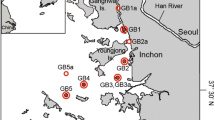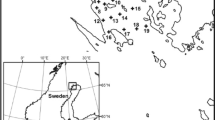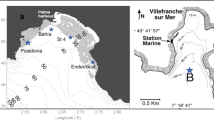Abstract
It is widely accepted that in many aquatic ecosystems bacterioplankton is dependent on and regulated by organic carbon supplied by phytoplankton, leading to coupled algae-bacteria relationship. In this study, an in-depth analysis of this relationship has been carried out by combining two approaches: (i) a correlation analyses between heterotrophic bacterial production (BP) vs. primary production (PP) or algal excretion of organic carbon (EOC), (ii) the balance between bacterial carbon demands (BCD) and the supply of C as EOC, measured as BCD:EOC ratio. During the study period (2013–2016), the algae-bacteria relationship was constantly changing from a coupling in 2013, uncoupling in 2014 and 2015, and an incipient return to coupling (in 2016). Our results show that top-down control (bacterivory) by algal mixotrophy acts as a decoupling force since it provides a fresh C source different to algal EOC to satisfy bacterial carbon demands. Notably, a relationship between the BCD:EOC ratio and the ecosystem metabolic balance (Primary production (PP): respiration (R)) was found, suggesting that PP:R may be a good predictor of the algae-bacteria coupling. This analysis, including the comparison between basal and potential ecosystem metabolic balance, can be a tool to improve knowledge on the interaction between both biotics compartments, which the traditional analyses on coupling may not capture.






Similar content being viewed by others
Data Availability
The datasets generated during and/or analysed during the current study are available from the corresponding author on reasonable request.
References
Cole JJ (1982) Interactions Between bacteria and algae in aquatic ecosystems. Annu Rev Ecol Syst 13:291–314. https://doi.org/10.1146/annurev.es.13.110182.001451
Kirchman D (1990) Limitation of bacterial growth by dissolved organic matter in the subarctic Pacific. Mar Ecol Prog Ser 62:47–54. https://doi.org/10.3354/meps062047
Mühlenbruch M, Grossart H-P, Eigemann F, Voss M (2018) Mini-review: phytoplankton-derived polysaccharides in the marine environment and their interactions with heterotrophic bacteria. Environ Microbiol 20:2671–2685. https://doi.org/10.1111/1462-2920.14302
Bird DF, Kalff J (1984) Empirical relationships between bacterial abundance and chlorophyll concentration in fresh and marine waters. Can J Fish Aquat Sci 41:1015–1023. https://doi.org/10.1139/f84-118
Cole JJ, Findlay S, Pace ML (1988) Bacterial production in fresh and saltwater ecosystems: a cross-system overview. Mar Ecol Prog Ser Oldendorf 43:1–10
Kritzberg ES, Cole JJ, Pace MM, Granéli W (2005) Does autochthonous primary production drive variability in bacterial metabolism and growth efficiency in lakes dominated by terrestrial C inputs? Aquat Microb Ecol 38:103–111. https://doi.org/10.3354/ame038103
Kritzberg ES, Cole JJ, Pace MM, Granéli W (2006) Bacterial growth on allochthonous carbon in humic and nutrient-enriched lakes: results from whole-lake 13C addition experiments. Ecosystems 9:489–499. https://doi.org/10.1007/s10021-005-0115-5
Carrillo P, Medina-Sánchez JM, Durán C et al (2015) Synergistic effects of UVR and simulated stratification on commensalistic phytoplankton–bacteria relationship in two optically contrasting oligotrophic Mediterranean lakes. Biogeosciences 12:697–712. https://doi.org/10.5194/bg-12-697-2015
Morán XAG, Estrada M, Gasol JM, Pedrós-Alió C (2002) Dissolved primary production and the strength of phytoplankton– bacterioplankton coupling in contrasting marine regions. Microb Ecol 44:217–223. https://doi.org/10.1007/s00248-002-1026-z
Durán-Romero C, Medina-Sánchez JM, Carrillo P (2020) Uncoupled phytoplankton-bacterioplankton relationship by multiple drivers interacting at different temporal scales in a high-mountain Mediterranean lake. Sci Rep 10:350. https://doi.org/10.1038/s41598-019-57269-y
Medina-Sánchez JM, Carrillo P, Delgado-Molina JA et al (2010) Patterns of resource limitation of bacteria along a trophic gradient in Mediterranean inland waters. FEMS Microbiol Ecol 74:554–565. https://doi.org/10.1111/j.1574-6941.2010.00969.x
Durán C, Medina-Sánchez JM, Herrera G, Carrillo P (2016) Changes in the phytoplankton-bacteria coupling triggered by joint action of UVR, nutrients, and warming in Mediterranean high-mountain lakes. Limnol Oceanogr 61:413–429. https://doi.org/10.1002/lno.10204
Thingstad TF, Bellerby RGJ, Bratbak G et al (2008) Counterintuitive carbon-to-nutrient coupling in an Arctic pelagic ecosystem. Nature 455:387–390. https://doi.org/10.1038/nature07235
Berggren M, Laudon H, Jonsson A, Jansson M (2010) Nutrient constraints on metabolism affect the temperature regulation of aquatic bacterial growth efficiency. Microb Ecol 60:894–902. https://doi.org/10.1007/s00248-010-9751-1
Freitas R, Vieira HH, de Moraes GP et al (2018) Productivity and rainfall drive bacterial metabolism in tropical cascading reservoirs. Hydrobiologia 809:233–246. https://doi.org/10.1007/s10750-017-3472-0
Sarmento H, Morana C, Gasol JM (2016) Bacterioplankton niche partitioning in the use of phytoplankton-derived dissolved organic carbon: quantity is more important than quality. ISME J 10:2582–2592. https://doi.org/10.1038/ismej.2016.66
Scofield V, Jacques SMS, Guimarães JRD, Farjalla VF (2015) Potential changes in bacterial metabolism associated with increased water temperature and nutrient inputs in tropical humic lagoons. Front Microbiol 6
Medina-Sánchez JM, Villar-Argaiz M, Carrillo P (2004) Neither with nor without you: a complex algal control on bacterioplankton in a high mountain lake. Limnol Oceanogr 49:1722–1733. https://doi.org/10.4319/lo.2004.49.5.1722
Onandia G, Miracle MR, Vicente E (2014) Primary production under hypertrophic conditions and its relationship with bacterial production. Aquat Ecol 48:447–463. https://doi.org/10.1007/s10452-014-9497-9
Mitra A, Flynn KJ, Burkholder JM et al (2014) The role of mixotrophic protists in the biological carbon pump. Biogeosciences 11:995–1005. https://doi.org/10.5194/bg-11-995-2014
Duarte CM, Prairie YT (2005) Prevalence of heterotrophy and atmospheric CO2 emissions from aquatic ecosystems. Ecosystems 8:862–870. https://doi.org/10.1007/s10021-005-0177-4
Scott JT, Doyle RD (2006) Coupled photosynthesis and heterotrophic bacterial biomass production in a nutrient-limited wetland periphyton mat. Aquat Microb Ecol 45:69–77. https://doi.org/10.3354/ame045069
Carrillo P, Medina-Sánchez JM, Villar-Argaiz M (2002) The interaction of phytoplankton and bacteria in a high mountain lake: Importance of the spectral composition of solar radiation. Limnol Oceanogr 47:1294–1306. https://doi.org/10.4319/lo.2002.47.5.1294
González-Benítez N, García-Corral LS, Morán XAG et al (2019) Drivers of microbial carbon fluxes variability in two oligotrophic mediterranean coastal systems. Sci Rep 9:17669. https://doi.org/10.1038/s41598-019-53650-z
Morán XAG, Gasol JM, Pedrós-Alió C, Estrada M (2002) Partitioning of phytoplanktonic organic carbon production and bacterial production along a coastal-offshore gradient in the NE Atlantic during different hydrographic regimes. Aquat Microb Ecol 29:239–252. https://doi.org/10.3354/ame029239
Fouilland E, Mostajir B (2010) Revisited phytoplanktonic carbon dependency of heterotrophic bacteria in freshwaters, transitional, coastal and oceanic waters. FEMS Microbiol Ecol 73:419–429. https://doi.org/10.1111/j.1574-6941.2010.00896.x
Morán XAG, Alonso-Sáez L (2011) Independence of bacteria on phytoplankton? Insufficient support for Fouilland & Mostajir’s (2010) suggested new concept. FEMS Microbiol Ecol 78:203–205. https://doi.org/10.1111/j.1574-6941.2011.01167.x
Fouilland E, Mostajir B (2011) Complementary support for the new ecological concept of ‘bacterial independence on contemporary phytoplankton production’ in oceanic waters. FEMS Microbiol Ecol 78:206–209. https://doi.org/10.1111/j.1574-6941.2011.01170.x
Fouilland E, Tolosa I, Bonnet D et al (2014) Bacterial carbon dependence on freshly produced phytoplankton exudates under different nutrient availability and grazing pressure conditions in coastal marine waters. FEMS Microbiol Ecol 87:757–769. https://doi.org/10.1111/1574-6941.12262
Goni-Urriza M, Moussard H, Lafabrie C et al (2018) Consequences of contamination on the interactions between phytoplankton and bacterioplankton. Chemosphere 195:212–222. https://doi.org/10.1016/j.chemosphere.2017.12.053
Hornick T, Bach LT, Crawfurd KJ et al (2017) Ocean acidification impacts bacteria–phytoplankton coupling at low-nutrient conditions. Biogeosciences 14:1–15. https://doi.org/10.5194/bg-14-1-2017
Kim B, An S-U, Kim T-H, Hyun J-H (2020) Uncoupling between heterotrophic bacteria and phytoplankton and changes in trophic balance associated with warming of seawater in Gyeonggi Bay, Yellow Sea. Estuaries Coasts 43:535–546. https://doi.org/10.1007/s12237-019-00606-1
Prieto A, Barber-Lluch E, Hernández-Ruiz M et al (2016) Assessing the role of phytoplankton–bacterioplankton coupling in the response of microbial plankton to nutrient additions. J Plankton Res 38:55–63. https://doi.org/10.1093/plankt/fbv101
Pringault O, Bouvy M, Carre C et al (2020) Impacts of chemical contamination on bacterio-phytoplankton coupling. Chemosphere 257:127165. https://doi.org/10.1016/j.chemosphere.2020.127165
Catalán J, Camarero L, Felip M et al (2006) High mountain lakes : extreme habitats and witnesses of environmental changes. Limnética 25:551–584
Parker BR, Vinebrooke RD, Schindler DW (2008) Recent climate extremes alter alpine lake ecosystems. Proc Natl Acad Sci 105:12927–12931. https://doi.org/10.1073/pnas.0806481105
Carrillo P, Medina-Sánchez JM, Villar-Argaiz M et al (2006) Complex interactions in microbial food webs : stoichiometric and functional approaches. Limnética 25:189–204
Mladenov N, Sommaruga R, Morales-Baquero R et al (2011) Dust inputs and bacteria influence dissolved organic matter in clear alpine lakes. Nat Commun 2:405. https://doi.org/10.1038/ncomms1411
Medina-Sánchez JM, Villar-Argaiz M, Carrillo P (2002) Modulation of the bacterial response to spectral solar radiation by algae and limiting nutrients. Freshw Biol 47:2191–2204. https://doi.org/10.1046/j.1365-2427.2002.00969.x
Medina-Sánchez JM, Cabrerizo MJ, González-Olalla JM et al (2022) High Mountain lakes as remote sensors of global change. In: Zamora R, Oliva M (eds) The Landscape of the Sierra Nevada: A Unique Laboratory of Global Processes in Spain. Springer International Publishing, Cham, pp 261–278
Carrillo P, Delgado-Molina JA, Medina-Sánchez JM et al (2008) Phosphorus inputs unmask negative effects of ultraviolet radiation on algae in a high mountain lake. Glob Change Biol 14:423–439. https://doi.org/10.1111/j.1365-2486.2007.01496.x
Korbee N, Carrillo P, Mata MT et al (2012) Effects of ultraviolet radiation and nutrients on the structure-function of phytoplankton in a high mountain lake. Photochem Photobiol Sci 11:1087–1098. https://doi.org/10.1039/c2pp05336e
Adrian R, O’Reilly CM, Zagarese H et al (2009) Lakes as sentinels of climate change. Limnol Oceanogr 54:2283–2297. https://doi.org/10.4319/lo.2009.54.6_part_2.2283
Williamson CE, Dodds W, Kratz TK, Palmer MA (2008) Lakes and streams as sentinels of environmental change in terrestrial and atmospheric processes. Front Ecol Environ 6:247–254. https://doi.org/10.1890/070140
Psenner R (1999) Living in a dusty world: airborne dust as a key factor for alpine lakes. Water Air Soil Pollut 112:217–227. https://doi.org/10.1023/A:1005082832499
Garcia-Herrera RF, Lionello P, Ulbrich U (2014) Preface: Understanding dynamics and current developments of climate extremes in the Mediterranean region. Nat Hazard 14:309–316. https://doi.org/10.5194/nhess-14-309-2014
Villar-Argaiz M, Medina-Sánchez JM, Cruz-Pizarro L, Carrillo P (2001) Inter- and intra-annual variability in the phytoplankton community of a high mountain lake: the influence of external (atmospheric) and internal (recycled) sources of phosphorus. Freshw Biol 46:1017–1034. https://doi.org/10.1046/j.1365-2427.2001.00734.x
Carrillo P, Reche I, Cruz-Pizarro L (1996) Intraspecific stoichiometric variability and the ratio of nitrogen to phosphorus resupplied by zooplankton. Freshw Biol 36:363–374. https://doi.org/10.1046/j.1365-2427.1996.00091.x
Medina-Sánchez JM, Villar-Argaiz M, Sánchez-Castillo P et al (1999) Structure changes in a planktonic food web: biotic and abiotic controls. J Limnol 58:213. https://doi.org/10.4081/jlimnol.1999.213
Villar-Argaiz M, Medina-Sánchez JM, Carrillo P (2002) Microbial plankton response to contrasting climatic conditions: insights from community structure, productivity and fraction stoichiometry. Aquat Microb Ecol 29:253–266. https://doi.org/10.3354/ame029253
Rice EW, Baird RB, Eaton AA (2017) Standard methods for the examination of water and wastewater, 23rd edn. American Public Health Association, Washington, DC
Nielsen ES (1951) Measurement of the production of organic matter in the sea by means of carbon-14. Nature 167:684–685. https://doi.org/10.1038/167684b0
Lignell R (1992) Problems in filtration fractionation of 14C primary productivity samples. Limnol Oceanogr 37:172–178. https://doi.org/10.4319/lo.1992.37.1.0172
Smith DC, Azam F (1992) A simple, economical method for measuring bacterial protein synthesis rates in seawater using 3H-leucine. Mar Microb Food Webs 6:107–114
Fuhrman JA, Azam F (1982) Thymidine incorporation as a measure of heterotrophic bacterioplankton production in marine surface waters: evaluation and field results. Mar Biol 66:109–120. https://doi.org/10.1007/BF00397184
Bell RT (1993) Estimating Production of heterotrophic bacterioplankton via Incorporation of tritiated thymidine. In: Handbook of methods in aquatic microbial ecology, 1st Edition. CRC Press, pp 495–503
Lee S, Fuhrman JA (1987) Relationships between biovolume and biomass of naturally derived marine bacterioplankton. Appl Environ Microbiol 53:1298–1303. https://doi.org/10.1128/aem.53.6.1298-1303.1987
González-Olalla JM, Medina-Sánchez JM, Lozano IL et al (2018) Climate-driven shifts in algal-bacterial interaction of high-mountain lakes in two years spanning a decade. Sci Rep 8:10278. https://doi.org/10.1038/s41598-018-28543-2
Morales-Baquero R, Pulido-Villena E, Reche I (2006) Atmospheric inputs of phosphorus and nitrogen to the southwest Mediterranean region: Biogeochemical responses of high mountain lakes. Limnol Oceanogr 51:830–837. https://doi.org/10.4319/lo.2006.51.2.0830
Morales-Baquero R, Pérez-Martínez C (2016) Saharan versus local influence on atmospheric aerosol deposition in the southern Iberian Peninsula: significance for N and P inputs. Glob Biogeochem Cycles 30:501–513. https://doi.org/10.1002/2015GB005254
Dorado-García I, Medina-Sánchez JM, Herrera G et al (2014) Quantification of carbon and phosphorus co-limitation in bacterioplankton: new insights on an old topic. PLoS One 9:e99288. https://doi.org/10.1371/journal.pone.0099288
del Giorgio PA, Cole JJ (1998) Bacterial growth efficiency in natural aquatic systems. Annu Rev Ecol Syst 29:503–541
Medina-Sánchez JM, Argaiz MV, Carrillo P (2006) Solar radiation-nutrient interaction enhances the resource and predation algal control on bacterioplankton: a short-term experimental study. Limnol Oceanogr 51:913–924. https://doi.org/10.4319/lo.2006.51.2.0913
Kamiya E, Izumiyama S, Nishimura M et al (2007) Effects of fixation and storage on flow cytometric analysis of marine bacteria. J Oceanogr 63:101–112. https://doi.org/10.1007/s10872-007-0008-7
Zubkov MV, Burkill PH, Topping JN (2007) Flow cytometric enumeration of DNA-stained oceanic planktonic protists. J Plankton Res 29:79–86. https://doi.org/10.1093/plankt/fbl059
Gasol JM, del Giorgio PA (2000) Using flow cytometry for counting natural planktonic bacteria and understanding the structure of planktonic bacterial communities. Sci Mar 64:197–224. https://doi.org/10.3989/scimar.2000.64n2197
Zubkov MV, Burkill PH (2006) Syringe pumped high speed flow cytometry of oceanic phytoplankton. Cytometry A 69A:1010–1019. https://doi.org/10.1002/cyto.a.20332
Gattuso J-P, Peduzzi S, Pizay M-D, Tonolla M (2002) Changes in freshwater bacterial community composition during measurements of microbial and community respiration. J Plankton Res 24:1197–1206. https://doi.org/10.1093/plankt/24.11.1197
Guillemette F, Leigh McCallister S, del Giorgio PA (2016) Selective consumption and metabolic allocation of terrestrial and algal carbon determine allochthony in lake bacteria. ISME J 10:1373–1382. https://doi.org/10.1038/ismej.2015.215
Reche I, Pulido-Villena E, Conde-Porcuna JM, Carrillo P (2001) Photoreactivity of dissolved organic matter from high-mountain lakes of Sierra Nevada, Spain. Arct Antarct Alp Res 33:426–434. https://doi.org/10.1080/15230430.2001.12003451
Delgado-Molina JA (2009) Efectos interactivos de radiación uv y pulsos de nutrientes sobre la red trófica microbiana: aproximación estructural, estequiométrica y funcional. Http://purl.org/dc/dcmitype/Text, Universidad de Granada
Reche I, Pugnetti A, Cruz-Pizzaro L, Carrillo P (1996) Relationship between bacteria and phytoplankton in a high-mountain lake: importance of the organic carbon released by pelagic algae for bacterioplankton. Ergebnisse der Limnologie 31–38
Morán XAG, Ducklow HW, Erickson M (2013) Carbon fluxes through estuarine bacteria reflect coupling with phytoplankton. Mar Ecol Prog Ser 489:75–85. https://doi.org/10.3354/meps10428
Billen G, Servais P, Becquevort S (1990) Dynamics of bacterioplankton in oligotrophic and eutrophic aquatic environments: bottom-up or top-down control? Hydrobiologia 207:37–42. https://doi.org/10.1007/BF00041438
Corno G, Jürgens K (2008) Structural and functional patterns of bacterial communities in response to protist predation along an experimental productivity gradient. Environ Microbiol 10:2857–2871. https://doi.org/10.1111/j.1462-2920.2008.01713.x
Pace ML, Cole JJ (1994) Comparative and experimental approaches to top-down and bottom-up regulation of bacteria. Microb Ecol 28:181–193. https://doi.org/10.1007/BF00166807
Bonilla-Findji O, Malits A, Lefèvre D et al (2008) Viral effects on bacterial respiration, production and growth efficiency: consistent trends in the Southern Ocean and the Mediterranean Sea. Deep Sea Res Part II Top Stud Oceanogr 55:790–800. https://doi.org/10.1016/j.dsr2.2007.12.004
Teira E, Hernando-Morales V, Fernández A et al (2015) Local differences in phytoplankton-bacterioplankton coupling in the coastal upwelling off Galicia (NW Spain). Mar Ecol Prog Ser 528:53–69. https://doi.org/10.3354/meps11228
Bird DF, Karl DM (1999) Uncoupling of bacteria and phytoplankton during the austral spring bloom in Gerlache Strait, Antarctic Peninsula. Aquat Microb Ecol 19:13–27. https://doi.org/10.3354/ame019013
Krishnan KP, Sinha RK, Nair S et al (2015) Carbon demand, utilization, and metabolic diversity of bacterioplankton in the frontal regimes of the Indian sector of the Southern Ocean. Ann Microbiol 65:1027–1036. https://doi.org/10.1007/s13213-014-0948-2
Medina-Sánchez JM, Delgado-Molina JA, Bratbak G et al (2013) Maximum in the middle: nonlinear response of microbial plankton to ultraviolet radiation and phosphorus. PLoS One 8:e60223. https://doi.org/10.1371/journal.pone.0060223
López-Sandoval DC, Fernández A, Marañón E (2011) Dissolved and particulate primary production along a longitudinal gradient in the Mediterranean Sea. Biogeosciences 8:815–825. https://doi.org/10.5194/bg-8-815-2011
Nagata T (2000) Production mechanisms of dissolved organic matter. Wiley Series in Ecological and Applied Microbiology
Wilhelm SW, Suttle CA (1999) Viruses and nutrient cycles in the sea: viruses play critical roles in the structure and function of aquatic food webs. Bioscience 49:781–788. https://doi.org/10.2307/1313569
López-Urrutia Á, Martin ES, Harris RP, Irigoien X (2006) Scaling the metabolic balance of the oceans. PNAS 103:8739–8744. https://doi.org/10.1073/pnas.0601137103
Woodward FI (2007) Global primary production. Curr Biol 17:R269–R273. https://doi.org/10.1016/j.cub.2007.01.054
Yvon-Durocher G, Jones JI, Trimmer M et al (2010) Warming alters the metabolic balance of ecosystems. Philos Trans R Soc B: Biol Sci 365:2117–2126. https://doi.org/10.1098/rstb.2010.0038
Mamouri R-E, Ansmann A, Nisantzi A et al (2016) Extreme dust storm over the eastern Mediterranean in September 2015: satellite, lidar, and surface observations in the Cyprus region. Atmos Chem Phys 16:13711–13724. https://doi.org/10.5194/acp-16-13711-2016
Acknowledgements
We are grateful to Manuel Villar-Argaiz and Javier Carretero Rodríguez for their support. We thank the Sierra Nevada National Park for the permission for field work. We appreciate the criticism of two anonymous reviewers who greatly improved the manuscript.
Funding
This study was funded by the PID2020-118872RB-I00 (MICIN/AEI/10.13039/501100011033) and FEDER/Junta de Andalucía-Consejería de Transformación Económica, Industria, Conocimiento y Universidades/Proyecto (B-RNM-310-UGR20) projects. This research is also part of the project “Thematic Center on Mountain Ecosystem & Remote sensing, Deep learning-AI e-Services University of Granada-Sierra Nevada'' (LifeWatch-2019–10-UGR-01), which has been co-funded by the Ministry of Science and Innovation through the FEDER funds from the Spanish Pluriregional Operational Program 2014–2020 (POPE), LifeWatch-ERIC action line.
Author information
Authors and Affiliations
Contributions
All authors conceived and designed the study and collected the data. IL Lozano made the analyses. JM Medina-Sánchez acquired and administrated the financing funds. IL Lozano wrote the first draft of the manuscript, and all authors reviewed, edited, and approved the final manuscript.
Corresponding author
Ethics declarations
Competing interests
The authors declare no competing interests.
Supplementary Information
Below is the link to the electronic supplementary material.
Rights and permissions
Springer Nature or its licensor (e.g. a society or other partner) holds exclusive rights to this article under a publishing agreement with the author(s) or other rightsholder(s); author self-archiving of the accepted manuscript version of this article is solely governed by the terms of such publishing agreement and applicable law.
About this article
Cite this article
Lozano, I., González-Olalla, J. & Medina-Sánchez, J. New Insights for the Renewed Phytoplankton-Bacteria Coupling Concept: the Role of the Trophic Web. Microb Ecol 86, 810–824 (2023). https://doi.org/10.1007/s00248-022-02159-6
Received:
Accepted:
Published:
Issue Date:
DOI: https://doi.org/10.1007/s00248-022-02159-6




